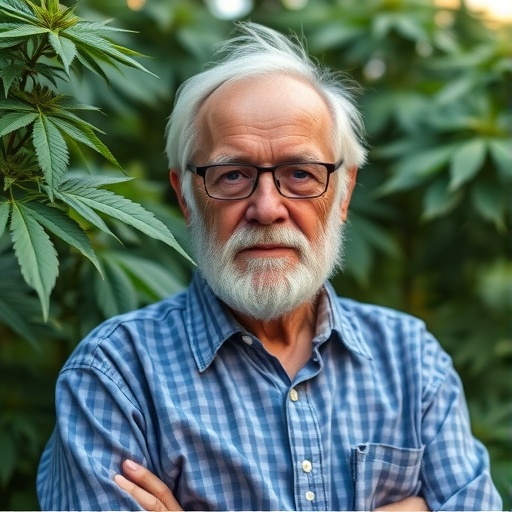
In recent years, cannabis use has emerged as a significant subject of public health interest, particularly within aging populations. A groundbreaking cross-sectional study published in JAMA Network Open offers vital insights into cannabis consumption patterns among U.S. veterans aged 65 to 84, revealing a surprisingly high prevalence of use and associated cannabis use disorder within this demographic. These findings challenge conventional assumptions about substance use in older adults and underscore the necessity for routine screening and clinical vigilance in healthcare settings serving veterans.
The study meticulously examined the prevalence of cannabis use among older veterans, highlighting that nearly one in three users engaged in consumption within the past 30 days. This rate approaches the prevalence of tobacco use in the same population, a startling comparison given the historical dominance of tobacco as the primary inhaled substance. The convergence of cannabis and tobacco use prevalence in seniors suggests evolving patterns of substance use influenced perhaps by changing social norms, increased legalization, and greater perceptions of cannabis as a medicinal or recreational agent.
Moreover, the investigation revealed a concerning association between frequent, inhaled cannabis use and elevated odds of developing cannabis use disorder. This disorder, characterized by problematic use leading to clinically significant impairment or distress, was present in over one-third of recent cannabis users in the cohort. The findings emphasize that while cannabis use may be common among older veterans, the risk of adverse outcomes—often underestimated in this demographic—is substantive and warrants medical attention.
The identification of risk factors for cannabis use in this older adult cohort mirrored those observed in broader populations, including younger adults. Variables such as psychosocial stressors, comorbid psychiatric conditions, and concurrent substance use appear to modulate cannabis initiation and escalation in aging veterans similarly to the patterns documented in prior epidemiological research. These parallels suggest that interventions effective in other demographic groups might be adapted for older adults to mitigate risk and promote healthier outcomes.
This research also delves into the mode of cannabis consumption, noting that inhalation remains the predominant method associated with cannabis use disorder. The pharmacokinetics of inhaled cannabis, which delivers rapid onset of psychoactive effects, may potentiate reinforcing behaviors and increase the likelihood of dependence compared to alternative delivery mechanisms such as edibles or tinctures. Understanding these nuances is critical for clinicians aiming to assess risk and counsel patients adequately.
The implications for the Veterans Health Administration (VHA) are profound. The high prevalence of use and associated disorder necessitate that healthcare providers incorporate routine screening protocols specifically targeting cannabis consumption in older adults. Such screenings would enable earlier identification of cannabis use disorder, facilitating timely interventions and reducing the burden of associated morbidity. This is particularly essential given the complex medical profiles of many veterans, who often manage multiple chronic conditions and polypharmacy.
Furthermore, the study propels a necessary conversation concerning the integration of substance use disorder services within geriatric care models. Because cannabis use in older adults has often been overlooked or minimized by healthcare systems, the development of tailored treatment paradigms responsive to the unique physiological and psychosocial needs of this group is urgently needed. These protocols must consider age-related changes in drug metabolism, cognitive vulnerabilities, and the potential interactions with prescribed medications.
Given the evolving legal landscape surrounding cannabis, older veterans may be increasingly exposed to conflicting information about its safety and benefits. Medical providers and policymakers must collaborate to produce clear, evidence-based guidance to help this population navigate decisions about cannabis use. The current study’s findings should inform educational campaigns to raise awareness among veterans and their caregivers about the risks associated with frequent inhaled cannabis use, particularly in the presence of underlying health challenges.
Additionally, the cross-sectional design of this study, while robust in capturing prevalence and associations at a fixed point in time, opens avenues for future longitudinal research to decipher causal pathways and temporal dynamics between cannabis use and development of disorder. Longitudinal data would be indispensable in delineating the trajectories of use, cessation, and relapse among older veterans, thereby refining prevention and treatment strategies.
The research also calls attention to the need for comprehensive clinical assessments that include detailed screening questions about cannabis frequency, method of use, and symptoms indicative of cannabis use disorder. Incorporating standardized tools into routine clinical practice would enhance detection accuracy and enable healthcare teams to deploy multidisciplinary approaches encompassing mental health, addiction specialists, and primary care providers.
Mental health comorbidities, which often intersect with substance use disorders, represent a significant concern in this demographic. The study hints at a constellation of overlapping risk factors that may exacerbate vulnerability in older veterans, such as depression, anxiety, and post-traumatic stress disorder. Thus, integrated care models that holistically address these interconnected issues stand as the ideal framework for managing older adults who use cannabis.
From a public health perspective, these findings highlight an urgent need for policy reforms and resource allocation that address cannabis use among older adults, moving beyond the traditional focus on younger populations. Targeted outreach, destigmatization efforts, and tailored harm reduction strategies should be designed to accommodate the specific circumstances that veterans face in later life.
In conclusion, the study offers powerful evidence that cannabis use is prevalent among veterans aged 65 to 84, with a significant subset exhibiting cannabis use disorder linked predominantly to frequent and inhaled consumption. Healthcare systems serving older adults, particularly within the Veterans Health Administration, must respond proactively by integrating comprehensive cannabis use screening and developing bespoke intervention frameworks. This work marks an essential step toward understanding and mitigating the complexities of cannabis use in aging populations, with broad implications for clinical practice, public health policy, and veteran wellbeing.
—
Subject of Research: Cannabis use and cannabis use disorder prevalence among older veterans aged 65 to 84.
Article Title: Not specified in the provided content.
News Publication Date: Not specified in the provided content.
Web References: Not specified; the embargoed link and doi (doi:10.1001/jamanetworkopen.2025.10173) were provided without active hyperlinks.
References: Not provided in the supplied excerpt.
Keywords: Cannabis, Older adults, Risk factors, Age groups, Tobacco, Population
Tags: cannabis use disorder in seniorscannabis use in older adultschallenges in substance use among elderlychanging social norms around cannabisclinical implications for healthcare providersimpacts of cannabis legalizationmedicinal cannabis perceptionsprevalence of cannabis use among veteranspublic health and aging populationsroutine screening for cannabis usesubstance use patterns in older adultstobacco and cannabis use comparison





